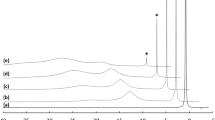Abstract
Raman spectroscopic measurements were performed on aqueous acid to neutral silica-bearing solutions (0.005 ≤ m Si ≤ 0.02, 0 ≤ pH ≤ 8) and Al–silica solutions at temperature from 20 to 150°C. At 20°C, the spectrum of silica-bearing solutions exhibits only the bands of water and a completely polarized band at 785 cm−1. This band is attributed to the ν1 band of the tetrahedral Si(OH)4 molecule. In \({\text{Si(OH)}}_{\text{4}} {\kern 1pt} {\kern 1pt} - {\kern 1pt} {\text{AlCl}}_3 {\kern 1pt} - {\kern 1pt} {\text{HCl}}\) solutions, the intensity of this band decreases with increasing Al concentration, temperature, and pH. This decrease can be explained by the formation of an inner sphere complex between Al3+ and Si(OH)4 according to the reaction: \({\text{Al}}^{{\text{3 + }}} {\text{ + H}}_{\text{4}} {\text{SiO}}_{\text{4}}^{\text{0}} ({\text{aq}}){\text{ }} \Leftrightarrow {\text{ AlH}}_{\text{3}} {\text{SiO}}_{\text{4}}^{{\text{2 + }}} {\text{ + H}}^{\text{ + }} \) The fraction of complexed silica deduced from raman spectroscopic measurements is in good agreement with that calculated for the similar solution compositions and temperatures using the complexation constant generated by Pokrovski et al. (23) from potentiometric measurements. At ambient temperature, the formation of aluminum silicate complex is weak and does not account for more than ca. 5 % of the total Al in most natural waters. As temperature increases, this complex becomes more significant and can dominate Al speciation in acid (pH ≤ 2) hydrothermal solutions.
Similar content being viewed by others

REFERENCES
R. K. Schofield and A. W. Taylor, J. Chem. Soc., p. 4445 (1954).
H. Kubota, Diss. Abstr. 16, 864 (1956).
C. R. Frink and M. Peech, Inorg. Chem. 2, 473 (1963).
R. E. Mesmer and C. F. Baes, Jr., Inorg. Chem. 10, 2290 (1971).
H. M. May, P. A. Helmke, and M. L. Jackson, Geochim. Cosmochim. Acta 43, 861 (1979).
N. S. Kuyunko, S. D. Malinin, and I. L. Khodakovsky, Geochem. Intern. 20, 76 (1983).
Y. Couturier, G. Michard, and G. Sarazin, Geochim. Cosmochim. Acta 48, 649 (1984).
P. L. Brown, R. N. Sylva, G. E. Batley, and J. Ellis, J. Chem. Soc., Dalton Trans., 1967 (1985).
D. A. Palmer and D. J. Wesolowski, Geochim. Cosmochim. Acta 56, 1093 (1992).
D. J. Wesolowski, Geochim. Cosmochim. Acta 56, 1065 (1992).
G. Verdes, R. Gout, and S. Castet, Eur. J. Mineral. 4, 767 (1992).
S. Castet, J. L. Dandurand, J. Schott, and R. Gout, Geochim. Cosmochim. Acta 57, 4869 (1993).
D. A. Palmer and D. J. Wesolowski, Geochim. Cosmochim. Acta 57, 2929 (1993).
D. J. Wesolowski and D. A. Palmer, Geochim. Cosmochim. Acta 58, 2947 (1994).
B. Sanjuan and G. Michard, Geochim. Cosmochim. Acta 51, 1823 (1987).
J. B. Fein, Geochim. Cosmochim. Acta 55, 955 (1991).
D. J. Wesolowski, D. A. Palmer, and G. M. Begun, J. Solution Chem. 19, 159 (1990).
P. Beńezeth, S. Castet, J. L. Dandurand, R. Gout, and J. Schott, Geochim. Cosmochim. Acta 58, 4561 (1994).
D. A. Palmer and J. L. S. Bell, Geochim. Cosmochim. Acta 58, 651 (1994).
I. Diakonov, G. Pokrovski, J. Schott, S. Castet, and R. Gout, Geochim. Cosmochim. Acta 60, 197 (1996).
B. A. Brown and C. T. Driscoll, Science 256, 1667 (1992).
V. C. Farmer and D. G. Lumsdon, Geochim. Cosmochim. Acta 58, 3331 (1994).
G. S. Pokrovski, J. Schott, J. C. Harrichoury, and A. S. Sergeyev, Geochim. Cosmochim. Acta 60, 2495 (1996).
F. Koroleff, Methods of Seawater Analysis (Springer-Verlag, Germany 1976).
R. Gout, G. Pokrovski, J. Schott, and A. Zwick, J. Raman Spectrosc. 28, 725 (1997).
J. Roux and C. Beny, Georaman-89: Contributions, 21 (ANRT, Paris, 1989).
C. F. Baes, Jr., and R. E. Mesmer, The Hydrolysis of Cations (Wiley, New York 1976).
M. Alves Marques, M. A. Sousa Oliveira, and J. Resina Rodrigues, J. Chem. Soc., Faraday Trans. 86, 471 (1990).
H. C. Helgeson and D. H. Kirkham, Amer. J. Sci. 274, 1199 (1974).
F. H. Sweeton, R. E. Mesmer and C. F. Baes, Jr., J. Solution Chem. 3, 191 (1974).
J. R. Ruaya and T. M. Seward, Geochim. Cosmochim. Acta 51, 121 (1987).
Author information
Authors and Affiliations
Rights and permissions
About this article
Cite this article
Gout, R., Pokrovski, G., Schott, J. et al. Raman Spectroscopic Study of Aluminum Silicate Complextion in Acidic Solutions from 25 to 150°C. Journal of Solution Chemistry 28, 73–82 (1999). https://doi.org/10.1023/A:1021703408311
Issue Date:
DOI: https://doi.org/10.1023/A:1021703408311


